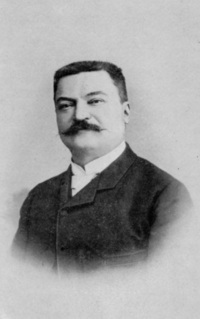Édouard Lucas: Difference between revisions
→External links: Fix a bug and add a link to the official the web-site of E. Lucas, which provides many of his numerous papers. |
|||
| Line 28: | Line 28: | ||
* {{MacTutor Biography|id=Lucas}} |
* {{MacTutor Biography|id=Lucas}} |
||
* [http://www.cs.wm.edu/~pkstoc/toh.html Scans of Lucas's original Tower of Hanoi puzzle in French, with translations] |
* [http://www.cs.wm.edu/~pkstoc/toh.html Scans of Lucas's original Tower of Hanoi puzzle in French, with translations] |
||
* [http://faculty.evansville.edu/ck6/bstud/lucas.html |
* [http://faculty.evansville.edu/ck6/bstud/lucas.html Édouard Lucas], by Clark Kimberling |
||
* [http://edouardlucas.free.fr/ Édouard Lucas], the official web-site. |
|||
[[Category:1842 births|Lucas, Edouard]] |
[[Category:1842 births|Lucas, Edouard]] |
||
Revision as of 21:52, 18 February 2007
François Édouard Anatole Lucas (April 4, 1842 in Amiens - October 3, 1891) was a French mathematician. Lucas is known for his study of the Fibonacci sequence. The related Lucas sequence is named after him. He gave a formula for finding the nth term of the Fibonacci sequence.

Lucas was educated at the École Normale Supérieure. He worked in the Paris observatory and later became a professor of mathematics in Paris. In the meantime he served in the army.
Lucas posed a challenge to prove that the only solution of the Diophantine equation:
with N > 1 is when N=24 and M=70. It was not until 1918 that a proof (using hyperelliptic functions) was found for this remarkable fact, which has relevance to the bosonic string theory in 26-dimensions [1].
He devised methods for testing the primality of numbers. He proved in 1876 that 2127−1 was prime; this would remain the largest known Mersenne prime for three-quarters of a century. Later Derrick Henry Lehmer refined his work and obtained the Lucas-Lehmer test for Mersenne numbers.
He worked on the development of the umbral calculus.
Lucas was also interested in recreational mathematics; He discovered an elegant binary solution to the Baguenaudier puzzle. He also more notably invented the Tower of Hanoi puzzle, which he marketed under the nickname N. Claus de Siam, an anagram of Lucas d'Amiens.
Lucas died in unusual circumstances. At the banquet of the annual congress of the Association française pour l'avancement des sciences a waiter dropped some crockery and a piece of broken plate cut Lucas on the cheek. He died a few days later of a severe skin inflammation probably caused by septicemia.
See also
External links
- O'Connor, John J.; Robertson, Edmund F., "Édouard Lucas", MacTutor History of Mathematics Archive, University of St Andrews
- Scans of Lucas's original Tower of Hanoi puzzle in French, with translations
- Édouard Lucas, by Clark Kimberling
- Édouard Lucas, the official web-site.

